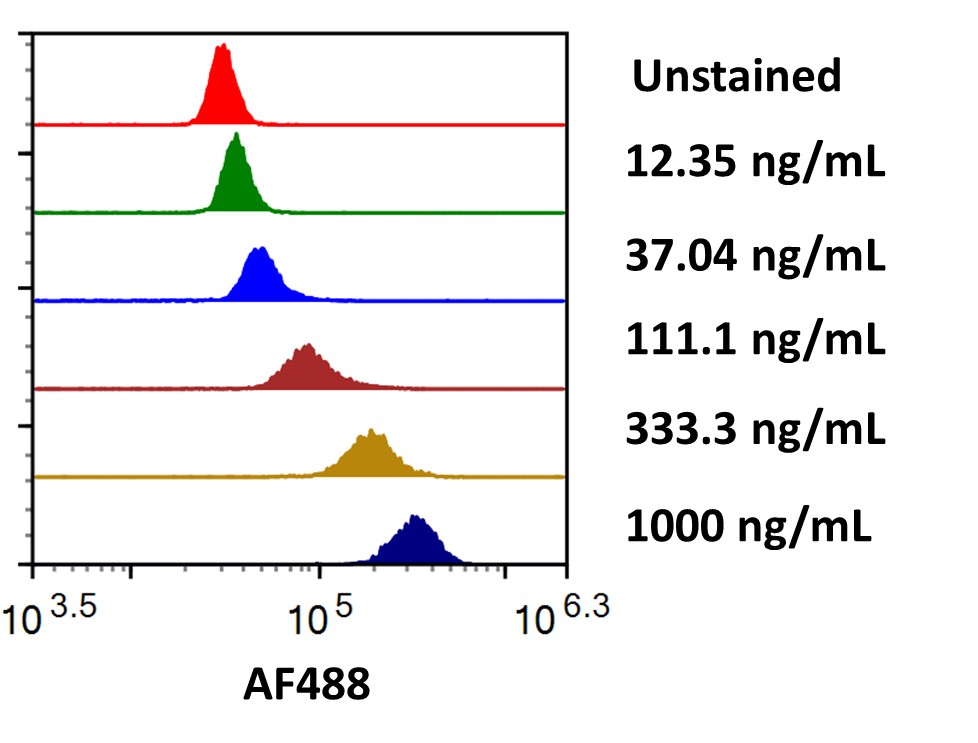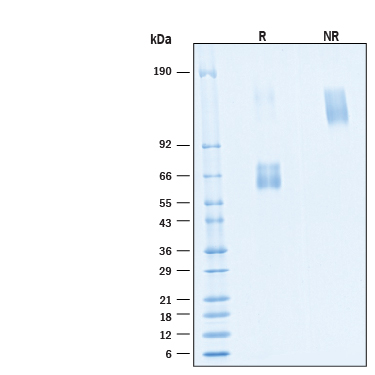Recombinant Human HVEM/TNFRSF14 Fc Alexa Fluor® 488 Protein
Recombinant Human HVEM/TNFRSF14 Fc Alexa Fluor® 488 Protein Summary
Learn more about FluorokinesTM Fluorescent-Labeled ProteinsProduct Specifications
| Human HVEM/TNFRSF14 (Pro37-Val202) Accession # Q92956.3 | IEGRMD | Human IgG1 (Pro100-Lys330) |
| N-terminus | C-terminus | |
Analysis
Excitation Wavelength: 488 nm
Emission Wavelength: 515-545 nm
Product Datasheets
AFG11177
| Formulation | Supplied as a 0.2 μm filtered solution in PBS with BSA as a carrier protein. |
| Shipping | The product is shipped with dry ice or equivalent. Upon receipt, store it immediately at the temperature recommended below. |
| Stability & Storage: | Protect from light. Use a manual defrost freezer and avoid repeated freeze-thaw cycles.
|
Scientific Data
 View Larger
View Larger
Streptavidin coated beads conjugated to biotinylated Anti-Human HVEM/TNFRSF14 were stained with the indicated concentrations of Recombinant Human HVEM/TNFRSF14 Fc Chimera Alexa Fluor® 488 (Catalog # AFG11177).
 View Larger
View Larger
2 μg/lane of Recombinant Human HVEM/TNFRSF14 Fc Chimera Alexa Fluor® 488 Protein (Catalog # AFG11177) was resolved with SDS-PAGE under reducing (R) and non-reducing (NR) conditions and visualized by Coomassie® Blue staining, showing bands at 55-75 kDa and 110-150 kDa, respectively.
Reconstitution Calculator
Background: HVEM/TNFRSF14
HVEM (herpesvirus entry mediator), also known as TNFRSF14 and CD270, is a type I membrane protein in the TNF receptor superfamily, and it can both promote and inhibit T cell activity (1). Mature human HVEM consists of a 164 amino acid (aa) extracellular domain (ECD) with three cysteine-rich domains (CRD), a 21 aa transmembrane segment, and a 60 aa cytoplasmic tail with a TRAF interaction domain (2, 3). Within the ECD, human HVEM shares 55% aa sequence identity with mouse and rat HVEM. Alternative splicing generates an additional isoform with a substitution of the N-terminal 10 amino acids including the signal peptide. HVEM is highly expressed on naïve CD4+ T cells, CD8+ T memory cells, regulatory T cells, dendritic cells, monocytes, and neutrophils (4-8). Its expression declines during effector T cell activation but is up-regulated during T reg activation (4, 5). HVEM functions as a receptor for BTLA, CD160, LIGHT/TNFSF14, and Lymphotoxin-alpha (4, 9‑12). Ligation of HVEM by LIGHT triggers T cell, monocyte, and neutrophil activation (8, 10) and contributes to Th1 inflammation and cardiac allograft rejection (13, 14). In contrast, HVEM binding to CD160 or BTLA suppresses T cell and dendritic cell activation (4, 7, 9, 10) and dampens intestinal inflammation (15). HVEM enhances the development of CD8+ T cell memory and T reg function (5, 6). It is additionally expressed on intestinal epithelial cells, where its binding by intraepithelial lymphocyte (IEL) expressed CD160 promotes epitheilal integrity and host defense (16). The herpesvirus envelope glycoprotein gD, which binds HVEM to initiate membrane fusion, can antagonize both BTLA and LIGHT binding (2, 9, 11).
- del Rio, M.L. et al. (2010) J. Leukoc. Biol. 87:223.
- Montgomery, R.I. et al. (1996) Cell 87:427.
- Hsu, H. et al. (1997) J. Biol. Chem. 272:13471.
- Sedy, J. R. et al. (2005) Nat. Immunol. 6:90.
- Tao, R. et al. (2008) J. Immunol. 180:6649.
- Steinberg, M.W. et al. (2013) PLoS One 8:e77992.
- de Trez, C. et al. (2008) J. Immunol. 180:238.
- Heo, S.K. et al. (2006) J. Leukoc. Biol. 79:330.
- Gonzalez, L.C. et al. (2005) Proc. Natl. Acad Sci. USA 102:1116.
- Cai, G. et al. (2008) Nat. Immunol. 9:176.
- Mauri, D.N. et al. (1998) Immunity 8:21.
- Harrop, J.A. et al. (1998) J. Biol. Chem. 273:27548.
- Wang, J. et al. (2005) J. Immunol. 174:8173.
- Ye, Q. et al. (2002) J. Exp. Med. 195:795.
- Steinberg, M.W. et al. (2008) J. Exp. Med. 205:1463.
- Shui, J.W. et al. (2012) Nature 488:222.
Product Specific Notices
This product is provided under an agreement between Life Technologies Corporation and R&D Systems, Inc, and the manufacture, use, sale or import of this product is subject to one or more US patents and corresponding non-US equivalents, owned by Life Technologies Corporation and its affiliates. The purchase of this product conveys to the buyer the non-transferable right to use the purchased amount of the product and components of the product only in research conducted by the buyer (whether the buyer is an academic or for-profit entity). The sale of this product is expressly conditioned on the buyer not using the product or its components (1) in manufacturing; (2) to provide a service, information, or data to an unaffiliated third party for payment; (3) for therapeutic, diagnostic or prophylactic purposes; (4) to resell, sell, or otherwise transfer this product or its components to any third party, or for any other commercial purpose. Life Technologies Corporation will not assert a claim against the buyer of the infringement of the above patents based on the manufacture, use or sale of a commercial product developed in research by the buyer in which this product or its components was employed, provided that neither this product nor any of its components was used in the manufacture of such product. For information on purchasing a license to this product for purposes other than research, contact Life Technologies Corporation, Cell Analysis Business Unit, Business Development, 29851 Willow Creek Road, Eugene, OR 97402, Tel: (541) 465-8300. Fax: (541) 335-0354.This product is provided under an agreement between Life Technologies Corporation and R&D Systems, Inc, and the manufacture, use, sale or import of this product is subject to one or more US patents and corresponding non-US equivalents, owned by Life Technologies Corporation and its affiliates. The purchase of this product conveys to the buyer the non-transferable right to use the purchased amount of the product and components of the product only in research conducted by the buyer (whether the buyer is an academic or for-profit entity). The sale of this product is expressly conditioned on the buyer not using the product or its components (1) in manufacturing; (2) to provide a service, information, or data to an unaffiliated third party for payment; (3) for therapeutic, diagnostic or prophylactic purposes; (4) to resell, sell, or otherwise transfer this product or its components to any third party, or for any other commercial purpose. Life Technologies Corporation will not assert a claim against the buyer of the infringement of the above patents based on the manufacture, use or sale of a commercial product developed in research by the buyer in which this product or its components was employed, provided that neither this product nor any of its components was used in the manufacture of such product. For information on purchasing a license to this product for purposes other than research, contact Life Technologies Corporation, Cell Analysis Business Unit, Business Development, 29851 Willow Creek Road, Eugene, OR 97402, Tel: (541) 465-8300. Fax: (541) 335-0354.
FAQs
No product specific FAQs exist for this product, however you may
View all Proteins and Enzyme FAQsReviews for Recombinant Human HVEM/TNFRSF14 Fc Alexa Fluor® 488 Protein
There are currently no reviews for this product. Be the first to review Recombinant Human HVEM/TNFRSF14 Fc Alexa Fluor® 488 Protein and earn rewards!
Have you used Recombinant Human HVEM/TNFRSF14 Fc Alexa Fluor® 488 Protein?
Submit a review and receive an Amazon gift card.
$25/€18/£15/$25CAN/¥75 Yuan/¥1250 Yen for a review with an image
$10/€7/£6/$10 CAD/¥70 Yuan/¥1110 Yen for a review without an image

